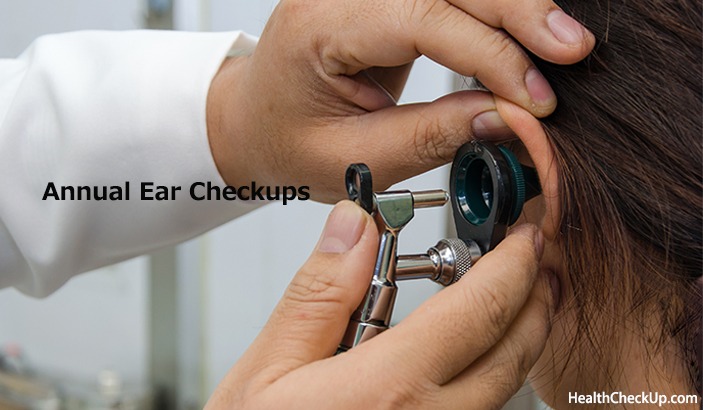People go for annual physical checkups to make sure that their body is in optimal condition. In most cases, they schedule exams that include an overall physical examination, eyes and teeth. Every system in the body, requires a thorough and complete examination to ensure that any potential health issues are discovered as early as possible.
But what about the auditory system? Unlike a toothache, you do not get a physical signal telling you that hearing loss is occurring. Because hearing declines gradually, most people take it for granted until they actually start noticing a problem. Therefore, it is important to make sure that your annual physical routine includes an ear checkup which is a thorough visual examination of the ear. An ear test helps in detecting problems such as ear pain, infection, hearing loss, excessive ear wax or lumps, discharge or objects in the ear.
How is an Ear checkup Performed?
A healthcare provider performs an ear examination by looking inside your ear with an instrument known as an otoscope. The lights in the room may be dimmed.
Young children are asked to lie down on their back with their head turned to one side. Their head may also rest on an adult’s chest. Older children and adults are asked to sit with their head tilted toward the shoulder opposite the examined ear.
The health care provider gently pulls back, up or forward on the ear to make the ear canal straight. The otoscope is then gently placed into the ear, shining a light beam into the ear canal. The provider slowly moves the instrument in different directions in order to see inside the ear and eardrum. In some cases, earwax can block this view. To get a magnified look inside of the ear, an ear specialist may use a binocular microscope.
A plastic bulb may be on the otoscope. Its function is to deliver a tiny puff of air into the outer part of the ear canal. This allows the examiner to see how the eardrum moves. Decreased movement can mean that the middle ear has fluid in it.
What are the Normal Results of an Ear Exam?
The size, shape and color of the ear canal vary from person to person. It normally has small hairs and is skin-colored. There may be presence of yellowish-brown earwax. The eardrum is usually a shiny pearly-white or light-gray color. When an otoscope is inserted into the ear, light from the otoscope should reflect off the eardrum’s surface.
What do Abnormal Results Mean?
One of the most common problems when it comes to the auditory system is an ear infection, especially with small children. When the light reflex in the eardrum is absent or dull, it may be an indication of fluid or middle ear infection. The eardrum may be bulging and red if it is affected by an infection. Amber bubbles or liquid are often seen behind the eardrum if liquid collects in the middle ear.
An external ear infection may also bring about abnormal results. You might experience pain when you wiggle or pull your outer ear. The ear canal may be swollen, red, tender or filled with greenish-yellow pus.
The ear test may be conducted for the following conditions:
- Chronic external ear infection
- Cholesteatoma
- Ruptured or perforated eardrum
- Head injury
Things to Consider
Not all ear problems can be detected through an otoscopy. It may necessary to get other ear and hearing tests.
Otoscopes that are sold for use at home are not as high quality as the ones that healthcare providers use. Parents may not be able to recognize some of the signs of an ear problem. You should make sure to visit a specialist if there are symptoms that include:
- Fever
- Dizziness
- Severe ear pain
- Ringing in the ears
- Hearing loss
- Bleeding or discharge in the ear
If you have an ear infection, keep in mind that there may be some pain or discomfort during the test. If the pain gets worse, your provider will stop the test.
Going for a yearly ear checkup is an important part of maintaining your health. You should make it an integral part of your annual physical examination. Do not wait until you have a problem to get your ears checked. Maintaining your ears ensures that it works properly at all times and that problems are detected as early as possible so that if you have one, you can treat it quickly. Keep every part of your body in optimal condition by getting a thorough, complete physical checkup every year.
Medically Reviewed By

Maanasi specializes in health topics including diet and nutrition. A mother of an untiring seven year old, she enjoys nurturing her love affair with English. She is often found nestled with a book, plopped against a dozen pillows, smiling away at the brink of finishing yet another book of the many dozens, that adorn the shelves of her Mini Library!








